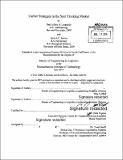| dc.contributor.advisor | Chris Caplice. | en_US |
| dc.contributor.author | Leopando, Paul Jeffrey Ramirez | en_US |
| dc.contributor.author | Rocca, Kyle A. C | en_US |
| dc.contributor.other | Massachusetts Institute of Technology. Engineering Systems Division. | en_US |
| dc.date.accessioned | 2015-01-05T20:01:31Z | |
| dc.date.available | 2015-01-05T20:01:31Z | |
| dc.date.copyright | 2014 | en_US |
| dc.date.issued | 2014 | en_US |
| dc.identifier.uri | http://hdl.handle.net/1721.1/92645 | |
| dc.description | Thesis: M. Eng. in Logistics, Massachusetts Institute of Technology, Engineering Systems Division, 2014. | en_US |
| dc.description | Cataloged from PDF version of thesis. | en_US |
| dc.description | Includes bibliographical references (pages 76-78). | en_US |
| dc.description.abstract | How an owner-operator chooses a specific load is a relatively unstudied field in transportation literature. Stakeholders in the decisions, such as freight brokers, stand to benefit from a better understanding of the selection process. Using load board data from a freight brokerage, we identified four parameters available to a carrier when a load is presented: length of haul, revenue per mile (RPM), the probability of finding an onward load from the destination, and the required mileage to reposition to the shipment origin. We also identified preferences of the owner-operators based on experience, literature, and the data, such as owner-operators' preference for long haul routes. We tested selection strategies that disintegrated the four load parameters and incorporated owner-operator preferences in a computerized simulation. We found that strategies combining two or more of the identified parameters provide better results in terms of revenue and utilization (% loaded) maximization. Furthermore, we found that including consideration of the empty repositioning distance was critical to success. Our simulated carriers outperformed peers in the dataset by up to 16%. Carriers can apply these insights to improve their operating strategies. Freight brokerages can apply the quantitative approach to advise their carrier clients and optimize the matching of freight with available carrier capacity. | en_US |
| dc.description.statementofresponsibility | by Paul Jeffrey R. Leopando and Kyle A.C. Rocca. | en_US |
| dc.format.extent | 78 pages | en_US |
| dc.language.iso | eng | en_US |
| dc.publisher | Massachusetts Institute of Technology | en_US |
| dc.rights | M.I.T. theses are protected by copyright. They may be viewed from this source for any purpose, but reproduction or distribution in any format is prohibited without written permission. See provided URL for inquiries about permission. | en_US |
| dc.rights.uri | http://dspace.mit.edu/handle/1721.1/7582 | en_US |
| dc.subject | Engineering Systems Division. | en_US |
| dc.title | Carrier strategies in the spot trucking market | en_US |
| dc.type | Thesis | en_US |
| dc.description.degree | M. Eng. in Logistics | en_US |
| dc.contributor.department | Massachusetts Institute of Technology. Engineering Systems Division | |
| dc.identifier.oclc | 898125398 | en_US |
